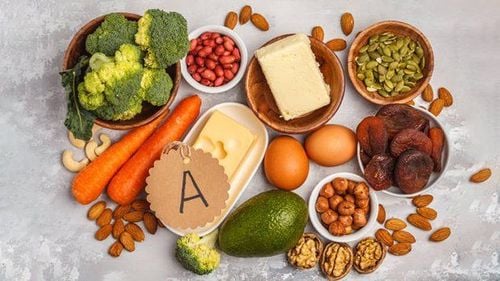This is an automatically translated article.
The rate of malnourished children with stunting in our country is still relatively high and there are clear differences between localities in the country. This will in the long run lead to a lower average height index for both men and women than other countries in the world and in Southeast Asia. So what to do with stunted children and what is the diet for stunted children?
1. What is stunting malnutrition?
Malnutrition is a condition in which the body lacks essential nutrients such as protein, various micronutrients... The cause of this condition may be due to inadequate diet or disease. . Malnutrition is divided into many different categories, of which stunting is used to describe children who do not meet the developmental milestones of height for age and sex.
Stunting is the result of long-term malnutrition or repeated diseases. Malnutrition and stunting also indicate that the child has not reached the genetic maximum height.
To accurately determine whether a child is stunted and to what extent, we need to measure the baby's lying length or standing height, then compare it with the height-for-age growth chart in each sex (in months) for children under 5 years old.
Measurement of lying length applies to children under 2 years old and measuring standing height is applicable to children aged 2 years and older. The frequency of measuring the length/height of children under 1 year old is once/month, for children 1 year old and older: every 2-3 months, children from 2 years old to under 5 years old can be measured once every 6 months. If the child is malnourished and stunted, it should be measured once a month for monitoring.
2. Why is stunting and malnutrition a concern?
Before learning about the question of what to do with stunted children, parents need to understand how this condition affects their baby's development. Malnutrition is considered one of the greatest human hindrances to growth and development, affecting 155 million children under the age of 5 worldwide.
In Vietnam, according to 2016 statistics, the rate of stunting among children under 5 years old is up to 24.3%, equivalent to 4 children, 1 child is stunted. Some factors associated with increased risk of stunting in children include low birth weight, education, parents' occupation, family economic level, maternal nutritional status and diseases. Children often have diseases such as diarrhea, fever... In which, some studies show that children with low birth weight have a very high risk of stunting when growing up.
Parents' education level is a related factor, which may lead to the limitation of parents' basic knowledge in child care and nurturing. Another problem is that poor household economics can affect children, increasing the likelihood of children being stunted because of the lack of adequate access to foods.
Besides, some studies prove that mothers with short height compared to the average height of Vietnamese people (<153cm) have a higher risk of having a child with stunted growth compared to other mothers. Then, malnourished girls grow up to be malnourished mothers and malnourished babies again, an irregular cycle that repeats itself.

Trẻ thấp còi phải làm sao khi người mẹ có chiều cao khiêm tốn
Malnutrition and stunting is a high risk factor for infant mortality, poor health both in childhood and adulthood, as a result, poor academic performance and work productivity and increased susceptibility to diseases. non-communicable diseases such as diabetes, cancer... in the future.
3. What to do with stunted children?
Most cases of stunting occur in the age group before 3 years old, this is the result of not getting enough food and the quality of food for children at this age is not guaranteed. So what should stunted children do, what should stunted children add to their nutrition to improve this situation?
To be most effective, interventions to prevent stunting should be initiated as early as possible, preferably during the golden 1000 day period - from conception to infancy. 2 years old. This will help children reach their full potential when raised in a healthy environment, cared for by proper health and nutrition services. Nutrition for stunted children will change from time to time:
3.1. Under 2 years old From the 7th month onwards, in addition to breast milk, children need to eat additional foods - solid foods, the number of daily weaning meals provided depends on the age of the child (such as: a 6-month-old child eats 1 powdered meals, children 7 - 9 months old eat 2-3 meals of denser powder, children 10 - 12 months old eat 3-4 meals of solid powder, children aged 1-2 years need to eat 4 more meals/day).
Try to breastfeed until baby is 2 years old or older, can drink 400 - 500ml of age-appropriate milk if breast milk is not available.
3.2. Pre-puberty and pubertal period Nutritional needs should be considered in the diet for stunted children in pre-pubertal and pubertal stages, energy needs depend on gender, age and need to ensure adequate nutrients needed:
Energy needs: girls' energy needs range from 1,900 - 2,300kcal/day and this figure is 2,100 - 2,800kcal/day for boys , to meet the child needs to be fed at least 3 meals/day, eat enough and full of nutrients. Protein: Protein is an essential nutrient for height and weight growth, protein helps to form the structure of cells, create hormones, and respond to immunity. body. Daily protein requirements are 50 - 70g in boys and 50-60g in girls, in which the ratio of animal protein/total protein is ≥ 35% and the energy provided from protein accounts for 13-20% energy of the whole child's diet. Suggested animal protein sources for parents are: meat, fish, eggs, milk, shrimp, crab..., vegetable protein sources include: beans, sesame, peanuts... Fat (lipid) : Fat is a great source of energy, fat helps to dissolve and absorb fat-soluble vitamins such as vitamins A, E, D, K. Fat needs of the child's body in the pre-puberty period. and puberty period is from 60 - 78g/day for boys and 55 - 66g/day for girls, parents need to balance the ratio of fat of animal origin and fat of vegetable origin. is 70:30, in which the energy provided by fat should account for 20-30% of the energy of the entire diet. Iron: Daily iron requirements are usually met through an iron-rich diet, however, in our country, the accessibility to animal foods with high biological value of iron is very low, so even at this stage, Pre-puberty and puberty, especially girls, need to take iron or multi-micronutrient supplements every week. Boys in this age group will have an iron requirement of 11-17mg/day, while girls need 11-29mg/day. Foods rich in iron of animal origin such as beef, chicken eggs, duck eggs, pig's heart, chicken liver... Vitamin A: Vitamin A is necessary for the normal growth and development of children at this stage. prepubertal and pubertal stage, helps to strengthen immunity, reduce infection and mortality rates. Vitamin A is abundant in animal foods of animal origin such as liver, eggs, milk ... and plants such as green vegetables, gac fruit, yellow fruits, so it is necessary to pay attention to supplementing foods rich in vitamin A. nutrition for stunted children. The daily requirement for vitamin A in adolescents is 800 μg/day in men and 650 μg/day in women.

Bổ sung vitamin A trong chế độ dinh dưỡng cho trẻ thấp còi
Calcium: this is a very necessary nutrient for puberty because the height growth rate at this age is very fast, the need for calcium increases up to 1000mg/day, calcium and phosphorus are ingredients to help maintain and form strong bones and teeth. The need for vitamin D in adolescence is 15μg/day. Zinc: Zinc is very necessary for the growth of weight and height of the body, zinc deficiency easily leads to anorexia due to taste disorders, daily zinc requirements are 9 - 10mg for men and 7-8mg for female. Foods rich in zinc that need to be added to the diet for stunted children are: shrimp, soybeans, eel, oysters, cockles, liver, milk, beef, egg yolks, fish, oil seeds. almonds, cashews, peanuts...). Vitamin C: This vitamin helps absorb and use iron, calcium and folic acid more effectively, helps fight allergies, boosts immunity, stimulates the body to produce bile and supports the protection of blood vessel walls. Vitamin C is abundant in green vegetables and ripe fruits with a daily requirement of 95mg.
Especially at this stage, babies need to add the necessary micronutrients: Zinc, selenium, chromium, vitamins B1 and B6, Ginger, acerola fruit extract (vitamin C),... to improve taste, eat well, reach the correct height and weight and exceed the standard, have a good immune system, strengthen the resistance to get sick less often and have less digestive problems.
For more nutritional knowledge and child care for each age, parents should regularly visit the website vimec.com and make an appointment with the leading doctors, pediatric and nutrition experts of the National General Hospital. Vinmec when needing advice on children's health.













